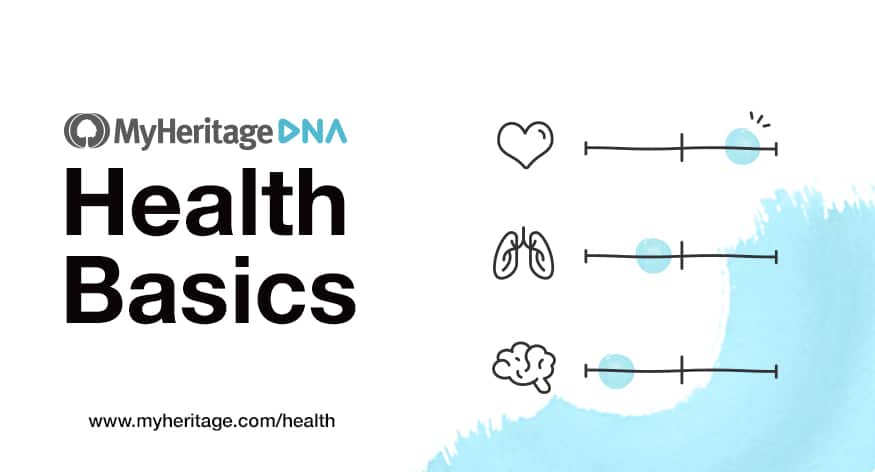As the average lifespan has grown over the past several decades, learning about your health and how to preserve it has become increasingly more important. Scientists are constantly uncovering new developments about the impact that genetics has on our long term health. Genetics, and what they mean for us personally, can be complicated. But learning how our genetics may impact our health can empower us to make different choices that can significantly change the long-term risk to develop certain conditions.
In this Health blog series, we’ll dive into hot topics related to DNA testing and health as well as how this testing can be incorporated into your overall health management plan. So, let’s get started!
How is the Risk for Complex Conditions Determined?
Ever wonder how much of a genetic component there is to heart disease? What about type 2 diabetes? Or breast cancer? There is a new technique that aims to combine DNA testing with mathematical modeling to answer that very question on a personal level. It is called a polygenic risk score (PRS). But what exactly is a polygenic risk score?
By definition, “poly-genic” means “more than one gene.” And unlike many definitions in health, this one accurately describes its meaning. Some health conditions are monogenic, meaning they are caused by a pathogenic or disease-causing variant in a single gene. For example, cystic fibrosis is a monogenic condition that is caused by a single mutation in the CFTR gene. While there are hundreds of monogenic conditions, the total number of people affected by any one of these conditions is fairly small. Common traits, on the other hand, like obesity and high blood pressure, and diseases like heart disease and diabetes, affect a significant number of the world’s population. The predisposition for these traits and diseases is actually controlled by a combination of many genes. They are, by that definition, polygenic. To provide an accurate risk assessment for these conditions, we need to look at the individual risks a person has at many locations across the genome and combine them. The cumulative result of those combined risks is called a polygenic risk score.

How is a PRS Calculated?
To determine a polygenic risk score, it is first necessary to assess your combined risk across hundreds, thousands, or even millions of variants. Each one of these variants typically makes a small contribution to your overall risk for the condition. To determine this overall risk, we need to model how to sum the contribution of all of these variants together.
The mathematical model used to calculate a PRS takes into account two things — the variants found in your DNA and the impact each one of those variants has on the likelihood you will develop the disease.
Knowing what variants to test comes from extensive review of what are called genome-wide association studies, GWAS (pronounced “G-wahs”) for short. GWAS studies include thousands to millions of people, usually from a specific ethnic population, some of whom have the disease or complex trait in question. Millions of variants across their genomes are tested, and the results of those with the disease are compared to those without to see how their variants differ. This creates a picture of variants that are more common in people with the disease and tells us what variants to look for in the DNA sample submitted from a Health kit.
Each variant has a unique contribution to the overall disease risk. This is called the “effect size.” The mathematical model takes this effect size into consideration, giving variants with larger effect sizes more weight than those with lesser effect sizes. So, when a sample is submitted, it is tested for the variants identified in the GWAS studies, and the results are input into the model. The model calculates the effect size at each variant and assesses the corresponding risk. The PRS is the sum of your individual risks at each of those variants.

Considerations with PRS
Currently, PRS reports are only available to those of European descent. That is because the vast majority of the GWAS studies that have been done looked mostly at people of that ethnic background. Since there could be differences in the variants that cause disease between people of different ethnic groups, GWAS studies are needed in each major ethnic group before PRS can be reliably calculated for people of non-European ancestry. Fortunately, large scale research efforts around the world are ongoing to try and address this problem. As this data is released, PRS reports will become available to those of additional ethnicities.
The other thing to consider with PRS is that it is most valuable when viewed as part of a holistic picture of health. Conditions like heart disease and obesity are largely influenced by lifestyle factors like diet, exercise, and BMI that you can control. The PRS is a guide that helps identify people who may not have known that they have a genetic risk, allowing them and their healthcare providers to be more proactive in their care.
Our next blog post will take a look at how to interpret a PRS report and what role it can have in proactive health management.
To learn more about genetic testing for health, visit myheritage.com/health today!












Andy Micklethwaite
October 26, 2019
Hereditary Hemochromatosis (HH) is not exactly Monogenic. There is one gene mutation C282Y that has been researched most, and can, on its own cause HH. But H63D and S65C are 2 others involved, and some studies suggest that up to 17 mutations are involved. Anecdotal evidence suggests that carriers can and do overload. Things in life are never simple! HH is one of the most common genetic conditions and can be fatal, and is seriously under-diagnosed, despite there being a simple blood test (serum ferritin) which is used to detect issues. has more on the condition which is most common in people of Celtic descent.